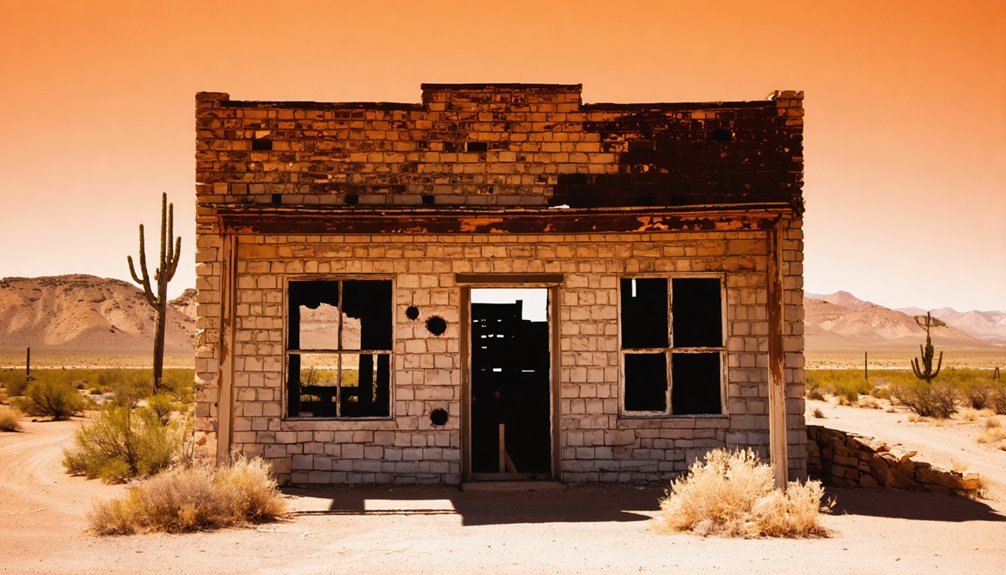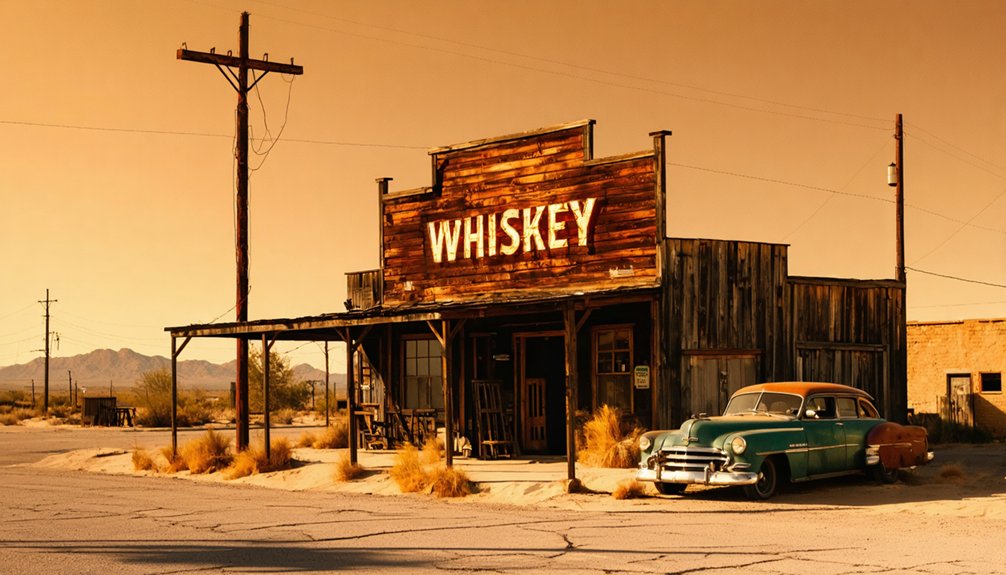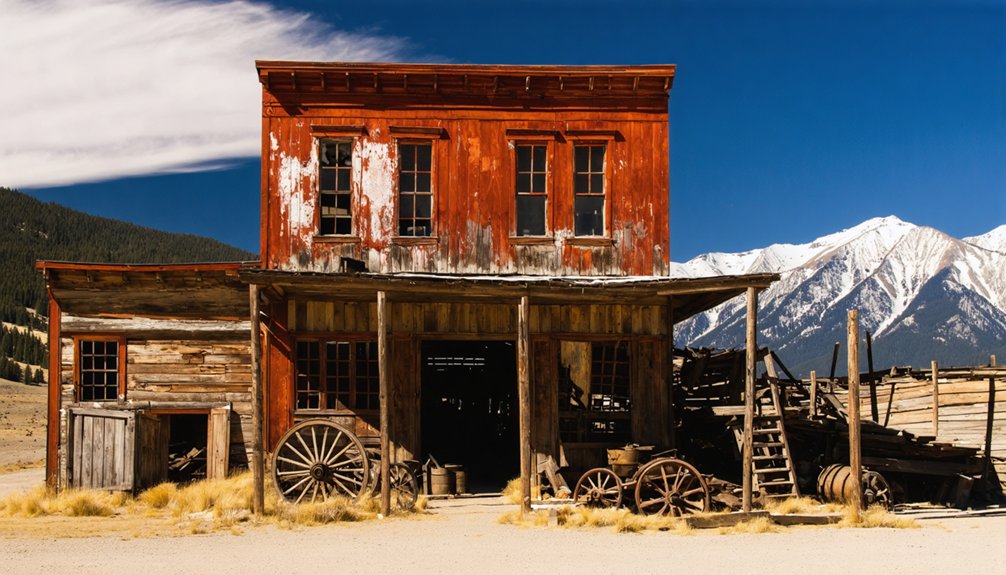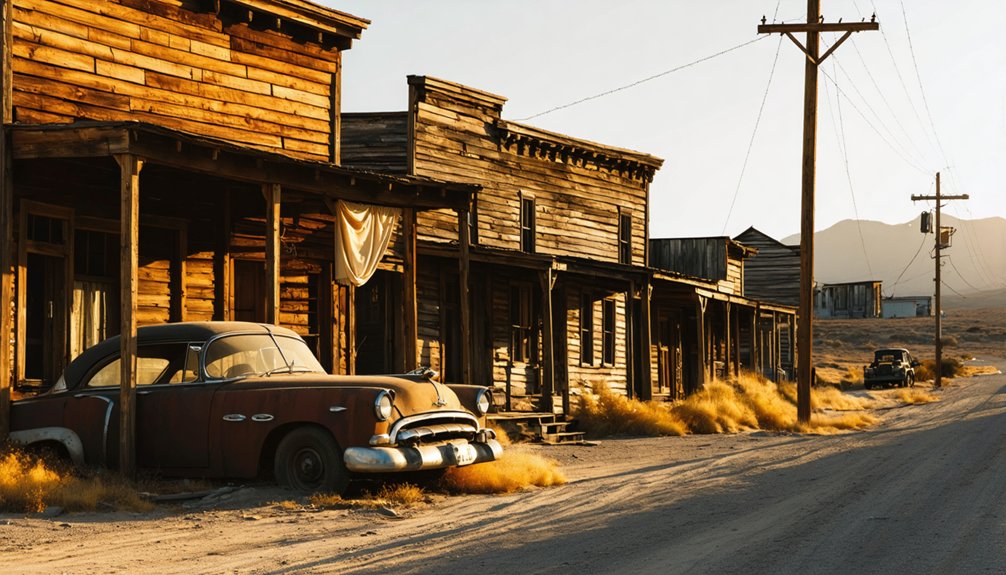Route 66’s ghost towns offer enchanting glimpses into America’s boom-and-bust frontier. You’ll discover Jerome’s Victorian architecture perched on an Arizona cliffside, Calico’s preserved silver rush buildings, and Rhyolite’s haunting Nevada ruins with outdoor art. Don’t miss Oatman’s wild burros, Alanreed’s historic Super 66 Station, Two Guns’ eerie Apache Death Cave, or Amboy’s iconic Roy’s Motel. These abandoned settlements reveal fascinating stories of forgotten dreams and Western resilience.
Key Takeaways
- Jerome, Arizona features Victorian architecture preserved through an artistic revival after being nearly abandoned following $800 million in copper extraction.
- Calico, California offers interactive silver mining exhibits and five original buildings as California’s Official Silver Rush Ghost Town.
- Rhyolite, Nevada showcases striking ruins including a Bottle House made from 50,000 beer bottles and contemporary desert art installations.
- Oatman, Arizona is home to wild burros and the historic Oatman Hotel where Clark Gable and Carole Lombard honeymooned in 1939.
- Amboy, California features the iconic Roy’s Motel and Café with its boomerang-shaped neon sign erected in 1959.
Jerome, Arizona: Victorian Mining Town Perched on Cliffside
Perched precariously on the slopes of Cleopatra Hill in Arizona’s Black Hills, Jerome’s story begins in 1875 with ambitious mining claims that would transform this mountainside into one of the West’s most notorious boomtowns.
You’ll find a town once teeming with 15,000 residents from 30+ nationalities, fueled by William Clark’s profitable copper empire.
By 1953, after extracting $800 million in copper, the mines closed, leaving Jerome nearly abandoned with barely 50 inhabitants.
Buildings that housed gambling halls and opium dens sat empty on unstable ground damaged by mining blasts and erosion.
The 1960s brought unexpected salvation through artistic revival.
Creators transformed bordellos into galleries and breathed new life into Jerome’s crumbling Victorian architecture, preserving its rich mining heritage while crafting a uniquely free-spirited community that thrives today.
Today, visitors can explore the town’s vertical layout while enjoying boutique shops, quirky attractions, and stunning views from this historic mountainside perch, or participate in the popular monthly Art Walk where local galleries showcase diverse artistic talents.
Calico, California: Preserved Silver Rush History on Route 66
You’ll step back into the 1880s silver rush era at Calico, California, where Walter Knott’s meticulous restoration preserved one-third of the original structures after the town’s boom-and-bust cycle left it abandoned by 1907.
Now operating as San Bernardino County’s official ghost town park, Calico showcases the region’s mining heritage through its reconstructed main street, Silver King Mine tours, and authentic Western events throughout the year. The town once had a thriving population that reached 3,500 by 1890 during the height of the mining boom. Only five buildings remain from the original town following its restoration in 1950.
The site’s designation as California’s Official Silver Rush Ghost Town in 2005 recognizes its significance as one of the state’s most productive silver mining operations, having yielded over $20 million in silver ore during its brief but prosperous heyday.
Silver Mining Heritage
Among the most enchanting ghost towns along Route 66, Calico stands as a monument to America’s silver rush era, where fortune-seekers once extracted over $86 million in silver from the harsh Mojave Desert landscape.
As you explore the reconstructed town, you’ll witness firsthand how miners employed sophisticated silver mining techniques, including grubstaking, narrow-gauge railroads, and massive stamp mills that processed ore from over 30 miles of underground tunnels.
The Maggie Mine, which yielded $13 million in silver, now invites you to walk through its historic passageways.
After the silver market collapsed in the 1890s, Calico fell silent until Walter Knott’s remarkable ghost town restoration in the 1950s preserved this slice of American freedom and entrepreneurial spirit.
Today, you can experience authentic mining history through interactive exhibits and demonstrations that bring the Old West back to life. The town’s faithful canine mascot Dorsey once delivered mail between Calico and nearby mines, becoming a legendary figure in the town’s colorful past. Don’t miss the iconic Bottle House constructed entirely from glass bottles, representing the resourcefulness of early settlers.
Restored County Park
After Walter Knott painstakingly purchased and restored Calico in the 1950s, this once-abandoned silver boom town found new life as a carefully preserved historical site.
In 1966, he donated the entire property to San Bernardino County, transforming it into a Regional Park that continues to safeguard this slice of American frontier history.
Today, you’ll discover only five original structures amid meticulously reconstructed buildings based on historical photographs. The site’s restoration techniques mirror the historical block printing methods that transformed the textile industry in the 18th century.
The park history comes alive through attractions like the Lucy Lane Museum and Maggie Mine tours.
While exploring, mind visitor safety warnings—the terrain is uneven, and abandoned mines pose serious hazards.
You’ll find the park welcoming visitors daily from 9 AM to 5 PM, with camping options available for those wishing to extend their journey into the past.
Authentic Western Events
Calico doesn’t merely preserve buildings—it brings history to life through authentic Western events that capture the spirit of the silver rush era. When you visit, you’ll experience living history demonstrations showcasing 1880s mining techniques in the same mountains that once yielded $20 million in silver ore.
The town’s calendar features gunfight reenactments, heritage festivals, and mining competitions that honor the 3,500 pioneers who called this desert outpost home during its heyday. These authentic events connect you directly to California’s officially designated Silver Rush Ghost Town, where miners blasted over 30 miles of tunnels beneath the colorful Calico Mountains. Visitors can also explore the Maggie Mine tour, offering a glimpse into the original silver mine operations and historical mining equipment.
Don’t miss seasonal celebrations where locals in period attire demonstrate western heritage skills, transforming this former boomtown from a silent museum into a vibrant representation of American frontier spirit.
Rhyolite, Nevada: Gold Rush Ruins and Desert Art Installations
Nestled in the sun-scorched Nevada desert, Rhyolite stands as a reflection of the fleeting nature of gold rush prosperity.
You’ll walk among ruins that once housed 5,000 souls who flocked here after the 1904 discovery by “Shorty” Harris and Ed Cross. Perfect for ghost town photography, the Cook Bank Building’s skeletal remains capture the dramatic rise and fall of mining camp history.
Unlike typical boom-and-bust settlements, Rhyolite boasted three-story banks, electricity, and railroads before its sudden collapse. The iconic Bottle House, constructed from 50,000 beer bottles, remains one of the most fascinating structures to explore.
Rhyolite’s grand amenities mocked the desert’s harsh reality before vanishing like a mirage in the Nevada sand.
By 1920, only 24 residents remained where thousands once dreamed of wealth.
Today, you’ll discover an unexpected artistic revival—the Goldwell Open Air Museum features surreal desert sculptures like “The Last Supper,” making Rhyolite a unique fusion of haunting history and contemporary desert art.
The 1906 San Francisco Earthquake contributed significantly to the town’s demise by triggering a financial panic that accelerated Rhyolite’s economic downfall.
Oatman, Arizona: Wild Burros and Daily Gunfights

Unlike many Route 66 ghost towns that have faded into obscurity, Oatman, Arizona thrives with a wild west authenticity you can’t find elsewhere. Founded after a gold strike in the early 1900s, this once-booming mining town (peaking at 10,000 residents) nearly vanished when the mines closed in 1924 and Route 66 bypassed it in 1953.
Today, you’ll witness descendants of miners’ pack animals roaming freely during burro encounters—these protected wildlife have become the town’s main attraction, with one even serving as honorary mayor.
Don’t miss the historic reenactments of gunfights at high noon on the main street. The leaning wooden buildings house memorabilia shops, while the Oatman Hotel—where Clark Gable and Carole Lombard honeymooned in 1939—displays thousands of signed dollar bills from visitors worldwide.
Alanreed, Texas: Oil Boom Memories and Historic Super 66 Station
Formerly known as Gouge Eye, Alanreed, Texas represents one of Route 66’s most authentic time capsules of America’s oil boom era.
With a population that once reached 500 during the 1920s Panhandle oil boom, today’s remaining 23 residents preserve the town’s rich history along the Mother Road.
From 500 oil-boom souls to just 23 guardians of history, Alanreed stands resilient along America’s Mother Road.
Don’t miss these Alanreed highlights:
- The Super 66 Station, built in 1930 and still operational, stands as a monument to Route 66’s golden age.
- Texas’ oldest Route 66 church (est. 1904) and cemetery, with the Baptist church proudly “Serving Route 66 Since 1904.”
- Original Route 66 pavement sections that once guided travelers before I-40’s 1982 completion sealed the town’s fate.
Bring supplies if you’re visiting – while the travel center remains open, amenities are limited in this living ghost town.
Two Guns, Arizona: Apache Death Cave and Frontier Lawlessness

Rising from the rugged landscape of northern Arizona, Two Guns stands as one of Route 66’s most haunting ghost towns, with a dark history steeped in frontier violence and notorious legends.
The infamous Apache Death Cave, where 42 Apache warriors perished in 1878 when Navajo fighters suffocated them after a raid, became the town’s macabre centerpiece.
Henry Miller, himself embodying frontier violence when he killed Earl Cundiff in 1926, transformed the site into a tourist attraction. He built a zoo, restaurant, and gift shop, even selling skeletal remains as souvenirs.
You’ll find only crumbling ruins today, with chicken-wire zoo cages and stone structures gradually reclaimed by the desert.
While historians debate the Apache legend’s authenticity, the town’s reputation for misfortune persists, fueled by tales of curses following the cave’s desecration.
Amboy, California: Roy’s Motel and Iconic Desert Americana
Nestled in California’s scorching Mojave Desert, Amboy stands as one of Route 66‘s most visually striking ghost towns, dominated by the unmistakable silhouette of Roy’s Motel and Café. Founded in 1938 by Roy Crowl, this roadside oasis once served thousands of travelers before Interstate 40’s opening in 1972 devastated the town’s economy.
Standing sentinel in the Mojave’s heat, Amboy captures Route 66’s faded glory through Roy’s iconic silhouette.
The landmark boomerang-shaped neon sign, erected in 1959, remains a beacon of mid-century Googie architecture and roadside Americana. Since 2005, preservationist Albert Okura has worked to restore this Route 66 icon to its former glory, despite significant challenges.
When you visit, notice:
- The classic gas station that once fueled America’s westward adventures
- The distinctive motel units that housed weary desert travelers
- The café space that served as Amboy’s social hub during its 700-resident heyday
Frequently Asked Questions
Are Ghost Towns Safe to Visit With Small Children?
Ghost town safety requires constant supervision with children. You’ll need to watch for structural hazards, wildlife, and extreme temperatures. Choose sites with child-friendly activities and designated viewing areas for best experiences.
What’s the Best Time of Year to Tour Route 66 Ghost Towns?
You’ll find Mother Nature’s finest paintbrush during Spring (May) and Fall (September). Avoid summer’s sweltering adventures over 105°F and winter’s desolation, embracing instead mild weather and freedom from tourist hordes along forgotten settlements.
Can You Stay Overnight in Any of These Ghost Towns?
You can’t stay overnight in true ghost towns, but you’ll find nearby overnight accommodations in towns like Barstow and Oatman that complement your ghost town experiences while ensuring your safety and comfort.
Are There Accessible Options for Visitors With Mobility Challenges?
While most ghost towns present challenges, you’ll find Calico offers mobility aids and some accessible routes. Other locations vary considerably – contact tour operators about wheelchair-accessible options for Route 66’s historic sites.
How Much Time Should Visitors Budget for Each Ghost Town?
Budget 30 minutes for basic ghost towns and up to two hours for developed sites like Oatman. You’ll need flexible time recommendations in your itinerary planning to accommodate unexpected discoveries along the way.
References
- https://www.legendsofamerica.com/66-ghosttowns/
- https://scholarcommons.sc.edu/scurs/2023symposium/2023schedule/56/
- https://www.youtube.com/watch?v=kS5yEKzlFoE
- https://usghostadventures.com/americas-most-haunted-trending/ghost-towns-to-visit-on-your-summer-road-trip-along-route-66/
- https://rvshare.com/blog/must-visit-ghost-towns-route-66/
- https://www.routemagazine.us/stories/loneliest-places-along-route-66
- https://dustyoldthing.com/route-66-ghost-towns/
- https://savingplaces.org/guides/ghost-towns-on-route-66
- https://build.imsglobal.org/abe-14/files?docid=Wsv24-7447&title=abandoned-towns-on-route-66.pdf
- https://www.youtube.com/watch?v=o9MTF3S_-Uk



